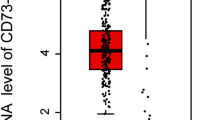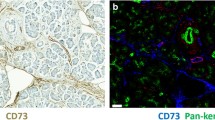Abstract
Background
Most pancreatic ductal adenocarcinomas (PDACs) metastasize even after curative resection. Our goal was to investigate the important factors affecting metastasis and overall survival (OS).
Methods
We studied 88 PDACs with R0 resection and evaluated immunohistochemical markers on tissue microarrays to assess the expression levels of the following: EGFR, amphiregulin, VEGF, p-c-met, MMP2, MMP7, MMP9, CXCR3, and CXCR4.
Results
The median OS in patients who had positive versus negative expression of AREG and MMP9 were 25 versus 16 months and 24 versus 13 months, respectively (P = 0.03, P = 0.006). However, the median OS in patients with positive versus negative expression of MMP2 was 22 versus 37 months (P = 0.04). Immunoprofiles also revealed that patients with positive expression of p-c-met or VEGF had significantly shorter distant metastasis-free survival. Adjuvant treatment, postoperative decrease of CA 19-9, angiolymphatic invasion, AREG, and MMP2 were independent prognostic factors affecting OS in multivariate analysis.
Conclusions
Immunoprofiles revealed the groups with unfavorable tumor biology: negative expression of AREG and positive expression of MMP2. Also, high immunoreactivity of p-c-met or VEGF seemed to be associated with early distant organ metastasis in R0 resected PDACs; however, they still need to be further investigated. These results may give us useful insights in understanding the tumor biology and the patterns of PDAC dissemination.


Similar content being viewed by others
References
Jemal A, Siegel R, Ward E, et al. Cancer statistics, 2007. CA Cancer J Clin. 2007;57:43–66.
Yeo CJ, Cameron JL, Sohn TA, et al. Six hundred fifty consecutive pancreaticoduodenectomies in the 1990s: pathology, complications, and outcomes. Ann Surg. 1997;226:248–57.
Real FX. A “catastrophic hypothesis” for pancreas cancer progression. Gastroenterology. 2003;124:1958–64.
Gupta GP, Massague J. Cancer metastasis: building a framework. Cell. 2006;127:679–95.
Pantel K, Brakenhoff RH. Dissecting the metastatic cascade. Nat Rev Cancer. 2004;4:448–56.
Joyce JA, Pollard JW. Microenvironmental regulation of metastasis. Nat Rev Cancer. 2009;9:239–52.
Christofori G. New signals from the invasive front. Nature. 2006;441(7092):444–50.
Chambers AF, Groom AC, MacDonald IC. Dissemination and growth of cancer cells in metastatic sites. Nat Rev Cancer. 2002;2:563–72.
Shoyab M, McDonald VL, Bradley JG, et al. Amphiregulin: a bifunctional growth-modulating glycoprotein produced by the phorbol 12-myristate 13-acetate-treated human breast adenocarcinoma cell line MCF-7. Proc Natl Acad Sci USA. 1988;85:6528–32.
Shoyab M, Plowman GD, McDonald VL, et al. Structure and function of human amphiregulin: a member of the epidermal growth factor family. Science. 1989;243(4894 Pt 1):1074–6.
Yarden Y, Sliwkowski MX. Untangling the ErbB signalling network. Nat Rev Mol Cell Biol. 2001;2:127–37.
Yotsumoto F, Yagi H, Suzuki SO, et al. Validation of HB-EGF and amphiregulin as targets for human cancer therapy. Biochem Biophys Res Commun. 2008;365:555–61.
Yamada M, Ichikawa Y, Yamagishi S, et al. Amphiregulin is a promising prognostic marker for liver metastases of colorectal cancer. Clin Cancer Res. 2008;14:2351–6.
Egeblad M, Werb Z. New functions for the matrix metalloproteinases in cancer progression. Nat Rev Cancer. 2002;2:161–74.
Freije JM, Balbin M, Pendas AM, et al. Matrix metalloproteinases and tumor progression. Adv Exp Med Biol. 2003;532:91–107.
Lopez-Otin C, Matrisian LM. Emerging roles of proteases in tumour suppression. Nat Rev Cancer. 2007;7:800–8.
Bramhall SR, Neoptolemos JP, Stamp GW, et al. Imbalance of expression of matrix metalloproteinases (MMPs) and tissue inhibitors of the matrix metalloproteinases (TIMPs) in human pancreatic carcinoma. J Pathol. 1997;182:347–55.
Gress TM, Muller-Pillasch F, Lerch MM, et al. Expression and in-situ localization of genes coding for extracellular matrix proteins and extracellular matrix degrading proteases in pancreatic cancer. Int J Cancer. 1995;62:407–13.
Scorilas A, Karameris A, Arnogiannaki N, et al. Overexpression of matrix-metalloproteinase-9 in human breast cancer: a potential favourable indicator in node-negative patients. Br J Cancer. 2001;84:1488–96.
Takeha S, Fujiyama Y, Bamba T, et al. Stromal expression of MMP-9 and urokinase receptor is inversely associated with liver metastasis and with infiltrating growth in human colorectal cancer: a novel approach from immune/inflammatory aspect. Jpn J Cancer Res. 1997;88:72–81.
Pozzi A, LeVine WF, Gardner HA. Low plasma levels of matrix metalloproteinase 9 permit increased tumor angiogenesis. Oncogene. 2002;21:272–81.
Hamano Y, Zeisberg M, Sugimoto H, et al. Physiological levels of tumstatin, a fragment of collagen IV alpha3 chain, are generated by MMP-9 proteolysis and suppress angiogenesis via alphaV beta3 integrin. Cancer Cell. 2003;3:589–601.
Birkedal-Hansen H. Matrix metalloproteinases. Adv Dental Res. 1995;9(3 Suppl):16.
Birkedal-Hansen H. Proteolytic remodeling of extracellular matrix. Curr Opin Cell Biol. 1995;7:728–35.
Juuti A, Lundin J, Nordling S, et al. Epithelial MMP-2 expression correlates with worse prognosis in pancreatic cancer. Oncology. 2006;71:61–8.
Desruisseau S, Palmari J, Giusti C, et al. Clinical relevance of amphiregulin and VEGF in primary breast cancers. Int J Cancer. 2004;111:733–40.
Smith RA, Tang J, Tudur-Smith C, et al. Meta-analysis of immunohistochemical prognostic markers in resected pancreatic cancer. Br J Cancer. 2011;104:1440–51.
Maulik G, Madhiwala P, Brooks S, et al. Activated c-Met signals through PI3 K with dramatic effects on cytoskeletal functions in small cell lung cancer. J Cell Mol Med. 2002;6:539–53.
Pisick E, Jagadeesh S, Salgia R. Receptor tyrosine kinases and inhibitors in lung cancer. Sci World J. 2004;4:589–604.
Ide T, Kitajima Y, Miyoshi A, et al. The hypoxic environment in tumor-stromal cells accelerates pancreatic cancer progression via the activation of paracrine hepatocyte growth factor/c-Met signaling. Ann Surg Oncol. 2007;14:2600–7.
Acknowledgment
Supported in part by internal fund #800-20090061SNU in the Department of Internal Medicine, Seoul National University College of Medicine, Seoul National University Hospital.
Author information
Authors and Affiliations
Corresponding authors
Additional information
Joo Kyung Park and Min A. Kim contributed equally to this work.
Electronic supplementary material
Below is the link to the electronic supplementary material.
Rights and permissions
About this article
Cite this article
Park, J.K., Kim, M.A., Ryu, J.K. et al. Postoperative Prognostic Predictors of Pancreatic Ductal Adenocarcinoma: Clinical Analysis and Immunoprofile on Tissue Microarrays. Ann Surg Oncol 19, 2664–2672 (2012). https://doi.org/10.1245/s10434-012-2277-7
Received:
Published:
Issue Date:
DOI: https://doi.org/10.1245/s10434-012-2277-7




